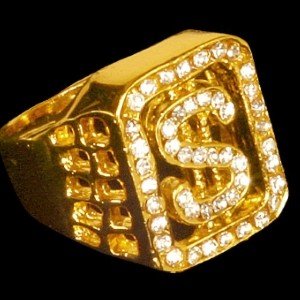USC Annenberg clinical professor Christopher Holmes Smith explored the emergence of a new type of American celebrity — the hip-hop mogul — in the Lear Center’s Celebrity, Politics and Public Life project, and he’s now exploring the limitations and possibilities of brands, advertising, celebrity advocacy and consumer philanthropy in our interdisciplinary faculty seminar BrandSpace.
 With the wisdom of hindsight, future historians may identify “bling” as an essential protein source at the deficit-financed economic banquet we’re now staggering away from. While the middle class binged on cheap credit—barely pausing to acknowledge catastrophic events like 9-11, Hurricane Katrina, and Abu Ghraib—hip-hop’s mavens of extravagance provided the guilt-free soundtrack for the feast.
With the wisdom of hindsight, future historians may identify “bling” as an essential protein source at the deficit-financed economic banquet we’re now staggering away from. While the middle class binged on cheap credit—barely pausing to acknowledge catastrophic events like 9-11, Hurricane Katrina, and Abu Ghraib—hip-hop’s mavens of extravagance provided the guilt-free soundtrack for the feast.
Coined exactly ten years ago by underground rapper BG and his colleagues in the New Orleans-based collective ‘Cash Money Millionaires,’ bling has become hip-hop’s single greatest contribution to the mainstream American lexicon.
A few web crawls for the term turn up over 23 million hits on Google, 500-plus profiles on Facebook and more than 13,000 lots for sale on eBay. While most of the auction booty falls in the categories of jewelry, watches, and apparel, there is also a long tail of cell phones and PDAs, wedding and party paraphernalia, electronics, automotive details, toys, sporting goods, pet supplies, and random kitsch like ‘pimp cups’ — outsized chalices embedded with precious, semi-precious and costume gems from which to enjoy your alcoholic “crunk” of choice.
Sadly, there’s no cultural equivalent of a ‘bad bank’ to serve as a clearing-house for this junk.
Such material excesses, however, form only part of the story. Bling also served symbolically in a post-Civil Rights politics that hip-hop’s elite peddled in the form of a seductive guarantee: long-standing social stratification could be effectively alleviated through aspirational product purchases.
This proposition was not entirely without virtue. Hip-hop’s mainstream appeal has gone a long way toward bringing otherwise socially isolated groups into closer proximity, especially within the millennial generation. And there’s no doubt the idiom’s multicultural cohort was a key element within the political base that propelled Barack Obama to his astonishing political victory.
Yet it is also true that like every other factor behind the enormous financial bubble, bling will not be sustainable, because the claims it makes on our future are not credible.
The socioeconomic conditions that enabled bling’s emergence were an anomaly, and they have now passed into posterity. Mainstream behavior has shifted accordingly. Luxury market revenues are down across a range of products, including champagne, high-end fashion, and even organic produce. Retail spending for durable goods is in sharp decline. Consumer bankruptcies have risen dramatically. After years of profligacy, average citizens have reset their material aspirations. Couple this with the Obama administration’s clear signal that thrift and civic responsibility will be hallmarks of the new commander-in-chief’s bully pulpit, and it appears as if bling’s decade-long reign may have finally run its course.
Hip-hop needs a corresponding attitude adjustment, or its status as an entertainment bellwether—once so secure—will be in jeopardy. Any reconsideration of acceptable consumption that the genre takes to heart will offer cultural balm to the consumer during the corporate and financial de-leveraging that will define our lives for some time to come. As President Obama proclaimed in his Inaugural Address, ‘The time has come to put away childish things.’
Welcome, my fellow Americans, to the dawn of the post-bling era.
